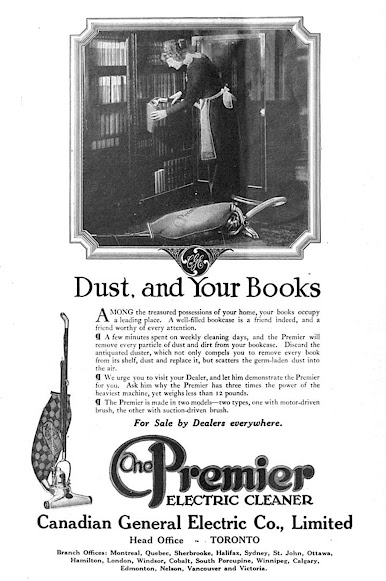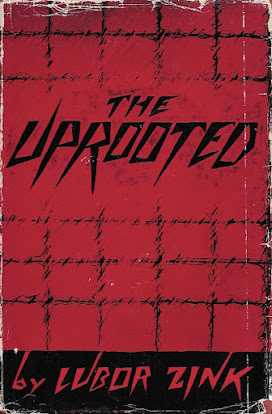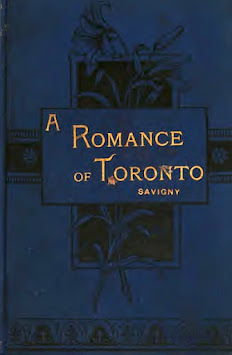 |
| Maclean's, 1 November 1920 |
09 December 2022
02 December 2022
Best Books of 1922: Amidst a Flood of Mediocrity
Published one hundred years ago today, the 1922 Globe round-up of the year's noteworthy books doesn't display much by way of enthusiasm. The three pages – previous years had five – begin with a reference to something once said by long-dead Englishman George Crabbe. It really sets the tone:
The trend may be away from fiction, but fiction makes for nearly half of the Globe's list. And I can't help but note that not one science title features.
The newspaper's greatest focus is on "GENERAL FICTION," by which it means fiction that is not Canadian. Babbit is recognized as the year's big title. I can't quibble because I still haven't read it. I have read The Beautiful and Damned, which doesn't feature.
 |
| My copies of the first Canadian editions |
The Return of Blue Pete - Luke Allan [Lacey Amy]Flowing Gold - Rex BeachChalk Talks - J.W. BengoughIndian Legends of Vancouver Island - Alfred CarmichaelGod's Green Country - Ethel M. ChapmanKing's Arrow - H.A. CodyCaste - W.A. FraserPagan Love - John Murray GibbonD'Arcy Conyers - Bertal HeeneyMortimer's Gold - Harold HornThe Timber Pirate - Charles Christopher JenkinsThe Bells of St Stephens - Marian KeithThe Dust Flower - Basil KingThe Twenty-first Burr - Victor LauristonOpenway - Archie P. McKinshieOver 'ere and Back Home - P. O'DTillicums of the Trail - George C.F. PringlePoisoned Paradise - Robert W. ServiceNeighbors - Robert SteadThe Prairie Child - Arthur StringerSalt Seas and Sailormen - Frederick William WallaceThe Shack Locker - Frederick William Wallace
 |
| My collection of the Globe's 1922 Canadian fiction titles. |
 |
| Four that didn't make the list. |
Really?
Most Canadian novels dating from this time have rural settings.
More, please?
The Globe is most complimentary in its opinion of Canadian verse, but not before taking a dig at the Mother Country: "In Britain, during the past year, deflation has not been confined to finance, and poetry scarcely rises above the horizon." But Canada, young Canada, imbued with "national sentiment stimulated by the war, receives refreshing satisfaction from the study of the poet's message."
Nine of the fourteen volumes of verse are Canadian:
Jean Blewett's Poems - Jean BlewettComplete Poems of Wilfred Campbell - Wilfred CampbellContrasts - Lawren HarrisComplete Poems of Archibald Lampman - Archibald LampmanFires of Driftwood - Isabel Ecclestone MackayThe Woodcarver's Wife and Later Poems - Marjorie L. PickthallChrist in the Strand and Other Poems - James A. RoyVerse and Reverse - Toronto Women's Press Club
Of the forty-seven, Over Prairie Trails by Frederick Philip Grove is in print today as a New Canadian Library title. New Canadian Library being no more, it's old stock now housed somewhere in a Penguin Random House warehouse.
What else is in print?
Nothing?
Oh, Canada.
Cyril's family is unaware that he and his cabinet-maker employee are making and selling false antique furniture. It is only when he dies and his salesman Bernie marries his widow Julie that the truth comes out through Cecil re-appearing as a parrot, puzzlingly given as a wedding gift. When a local Brighton heavy realises he's been conned the family band together to try and fix things.
01 December 2022
'December' by S. Frances Harrison
An old poem for the New Month by daughter of Toronto Susie Frances Harrison (née Riley; a/k/a Seranus). This version comes from her second collection, Pine, Rose and Fleur de Lis (Toronto: Hart & Co, 1891).
I long for a noble mood. I long to rise,Like those large rolling clouds of ashen pinkThat deepen into purple, over strifeAnd small mechanic doings. How superbThat landscape in the sky to which I walk,And gain at will a spacious colour-world,In which my finer self may feel no fear!The distance far between that goal and meSeems lightly bridged; breathless, I win that goal—The shores of purple and the seas of gold.Below, how flat the still small earth—a sphereThat only the leaden soul takes solace in!The long pine stretches, barred in sombre black,Cross at right-angles fields that are gray with snow—Not white, but gray, for all the colours is here,Colour—a new sacrament—melted gems,The hearts of all water-lilies, the tips of their wings—Young angels', plumed in topaz, garnet, rose—The dazzling diamond white, the white of pearl.How poor a place the little dark world appears,Seen from this gold-cloud region, basoned in fire!Only a step away, and nothing is seenOf the homes, huts, churches, palaces it bearsUpon its dry brown bosom. There remainsBut the masterful violet sea, that angrilyThis moment somewhere gnashes its yellow teethAgainst a lonely reef. What's most like GodIn the universe, if not this same strong sea,Encircling, clasping, bearing up the world,Blessing it with soft caresses, then, for faults,Chiding in God-like surges of wrath and storm?But the ocean of cloud is placid, and the shores,Rolled up in their amethyst bulk towards the stars,Fade noiselessly from pearl to purple dark.The shades fall even here. Here—not exemptFrom death and darkness even these shining airs—The night comes swifter on than when on earth.The fringes of faintest azure, where the barsOf paler cloud are fading into gray,Are dulled and blotted out. Opaque has grownThe molten in one moment; fleecy paleAnd ghastly all the purple lonely then,And awed to horror of those glacial peaks,I bridge the vaporous barrier once again,And tread the despised earth. Then how too dearDoth the rude, common light of earth appear—That of a street lamp, burning far, but clear!The sign of human life, of human love,Of habitation sweet, of common joysAnd common plans, though precious, yet not prized,Till in a moment's fancy I had lost them.
30 November 2022
28 November 2022
The Dustiest Bookcase: Z is for Zink (Again)
Lubor Zink
Toronto: Longmans Canada, 1962
343 pages
Hilarious.
 |
| Trudeauacracy Lubor J Zink [Toronto]: [Toronto Sun], 1972 |
21 November 2022
A Romance of Toronto: CanLit Most Verbose
Toronto: William Briggs, 1888
229 pages
Two gentlemen friends saunter arm in arm up and down the deck of the palace steamer Chicora as she enters our beautiful Lake Ontario from the picturesque Niagara River, on a perfect day in delightful September, when the blue canopy of the heavens seems so far away, one wonders that the mirrored surface of the lake can reflect its color.
 |
| Cliquez pour agrandir. |
In her introductory note, Mrs Savigny describes A Romance of Toronto as a novel consisting of two plots.
Dale and Buckingham have nothing to do with either.
The first involves young Charles Babbington-Cole. He knows Mrs Gower through his father, Hugh Babbington-Cole. A widower in frail health, Babbington-Cole père was once engaged to a wealthy Englishwoman. Tragically, the union was prevented through conniving and lies told the bride-elect by the sister of his late wife. The Englishwoman instead married her guardian with whom she had a daughter. When the sister-in-law's malfeasance was exposed Hugh Babbington-Cole and the Englishwoman – identified only as "Pearl" – vow that their offspring will one day wed and together inherit her riches.
And so, Charles Babbington-Cole bids Mrs Gower adieu, embarking for England and a storyline that reads like a very bad imitation of May Agnes Fleming; kidnapping, false identity, forced marriage, and a gothic manor house will figure.
The second plot – much more absurd, yet somehow less interesting – concerns Mrs Gower herself. A woman who has has twice worn the black robes of widowhood, she is cornered into accepting a marriage proposal from Mr Cobbe, by far the most repellent of her social set. Mrs Gower tells Mrs Drew how this came to be in 'The Oath in the Tower of Toronto University,' the novel's sixteenth chapter. This is its beginning:
 |
| Cliquez pour agrandir. |
Nothing is spoiled in reporting that all ends happily; the first of the novel's two epigraphs suggests as much.
"Don't you think, Lilian, that the opposite sex is usually chosen to lend an ear?" she said, carelessly, to conceal a feeling of sadness at the out-going of her friend; for she is aware that the old friendly intercourse is broken, now that he has gone to his wedding.
"I am so glad he has come into my life: I feel lonely at times; and he is so companionable, I know. What dependent creatures we are, after all—houses and lands, robes a la mode, even, don't suffice. Intercourse we must have."
Object and Access: A deceptively slim hardcover. Fifty years after publication, my copy was added to the library of the Department of the Secretary of State. One wonders why. Might it have something to do with the suggestion that A Romance of Toronto is a roman à clef? I'm guessing not, but like to imagine otherwise.
A Romance of Toronto was reprinted in 1973 by the University of Toronto. If anything, that edition is even more rare. Long in the public domain, it continues to be picked over by print on demand vultures. This cover is my favourite by far:
12 November 2022
Murray and the Argonauts
H Bedford-Jones
New York: Doubleday, 1923
120 pages
Note: Arizona Argonauts is a novella infused with racial epithets.Reader discretion is advised.
The first chapter is very strong. It begins with a conversation between Piute Tompkins and Deadoak Stevens, men of prominence in the dried-up former mining town of Two Palms, Arizona. There are two topics, the longest running involves their five-year-old investment in wells, pumping machinery, cement irrigation pipe, pear trees, and almond trees. They hope to see some return in another five years. Of more recent interest is Tom Lee, a "Chinee" who is staying at Piute's hotel. The proprietor sees his lodger as a mystery:
"Ain't he? He is. Him, and that girl, and what in time they're a-doing here."
"Even so," echoed Deadoak, as he rolled a list-less cigarette. "Who ever heard of a chink ownin' a autobile? Not me. Who ever heard of a chink havin' a purty daughter? Not me. Who ever heard of a chink goin' off into the sandy wastes like any other prospector? Not me. I'm plumb beat, Piute!"
The second chapter – there are thirteen in total – is even better. The focus here is Sandy Mackintavers. Six weeks before Piute and Deadoak's conversation, Sandy had been a player in New Mexico. A man whose "unscrupulous fingers had been clutched deep in a score of pies,
sometimes leaving very dirty marks about the edge." However:
Somewhere a cog slipped; he had been indicted for bribery. That had broken the thick crust of fear which had enveloped him, had released his enemies from the shackles of his strong personality. Overnight, it seemed, a dozen men went into the courts against him, backed by the evidence of those who had taken his money and had done his dirty work.Now broken and very nearly broke, Mackintavers drives aimlessly with the remnants of his once significant wealth tucked in his sock. He stops to offer two tramps a ride. The more talkative of the pair is skilled surgeon Douglas Murray. Two years earlier, Mackintavers paid the good doctor an even thousand dollars to remove his appendix. Murray was on top of his game back then, earning big money hand over scalpel:
"It was success that downed me — too much work. I had to keep going twenty hours a day to save human lives during the influenza epidemic. It started me working on dope. I knew better, of course, but thought myself strong.
"The dream book got me at last, like it gets all the fools. One day, in the middle of an operation, I broke down. I had to have a shot quick, and I got it. I had to do it openly, if the man on the table were not to die; so I did it."
Though Murray managed to conquer "the dream book," the addiction left his reputation in tatters and emptied his wallet. The doctor's travelling companion is a reformed safecracker named Hobbs. Murray discovered Hobbs lying in a ditch, performed a roadside operation, and the two have been fast friends ever since. Mackintavers finds himself in the company of two men who, taken down a peg or three, look to become better people. Having recently suffered his own comeuppance, he's all of a sudden keen to follow their example.
Mackintavers, Murray, Hobbs meander into Two Palms, where they are immediately taken for a trio of rubes. Piute and Deadoak conspire to unload a worthless piece of land. Mackintavers, who knows a thing or two about mining, takes the deal. And then Tom Lee makes a more generous offer.
Arizona Argonauts is the first thing I've ever read by Bedford-Jones. Because he was so very prolific – the man published twenty-five novellas and short stories that same year – I'd made the mistake of thinking he couldn't be any good.
I should've known better; no one publishes that much without some degree of talent.
Bedford-Jones weaves a really good story of mystery, intrigue, violence, and romance. His dialogue is sharp and characters uncommon. Murray is one of two who've struggled with drug addiction, the other being "yellow man" Lee.
As I was sayin', Bill, it was the gosh-willingest thing I ever struck! Think o 'me purposin' mattermony, right off the bat like that — and a good-lookin' girl, I'm sayin'! And when she was feelin' around for the right words to accept me, prob'ly meanin' to fish around an' make me urge her a mite, I seen her ol' man come walkin' along. In about two shakes I seen he was a chink.""Yes?" The proprietor tipped Murray a wink, and set forth the ice cream."What then?" "I faded right prompt," said the desert rat. "Right prompt! I dunno — It kind o' dazed me fer a spell. When I got into Two Palms next day, I was tellin' Piute Tomklns about it, and he up an' says them two was stayin' at his hotel — the chink and the girl, which same bein' his daughter, he allowed it was all right an' proper. I judge Piute was soakin' them right heavy, else he wouldn't ha' stood for chinks boardin' on him. Piute has his pride — .
Arizona Argonauts first appeared in the May 1920 edition of Short Stories. Did its early readers focus on issues of race? I'm guessing not. The budding romance between Claire and Murray is just one of the story's many threads. What I can say for certain is that Arizona Argonauts is not at all what I expected.
Object and Access: A cheap early American paperback with blank back cover. I believe my 1923 copy marks the novella's first appearance in book form. A 1924 Doubleday edition can be read online here at the Internet Archive. Date aside, the only difference I see is the inclusion of an illustration (above) not found in the former. As might be expected, the scene does not feature in the novella.
Library and Archives Canada and three of our academic university libraries have one or another of Doubleday's editions.
The very same issue features 'The Silent City,' a short story credited to H Bedford-Jones and "W.C Robertson" (which is thought to be one of Bedford-Jones's pseudonyms). 'Guilty,' by fellow Canadian Theodore Goodridge Roberts also features.

























